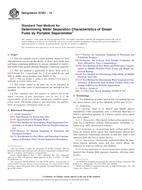We need your consent to use the individual data so that you can see information about your interests, among other things. Click "OK" to give your consent.
ASTM D909-14
Standard Test Method for Supercharge Rating of Spark-Ignition Aviation Gasoline
STANDARD published on 1.5.2014
The information about the standard:
Designation standards: ASTM D909-14
Note: WITHDRAWN
Publication date standards: 1.5.2014
SKU: NS-39722
The number of pages: 17
Approximate weight : 51 g (0.11 lbs)
Country: American technical standard
Category: Technical standards ASTM
The category - similar standards:
Annotation of standard text ASTM D909-14 :
Keywords:
ICS Number Code 75.160.20 (Liquid fuels)
Additional information
| Significance and Use | ||||||||||||||||||||||||||
|
5.1 Supercharge method ratings can provide an indication of the rich-mixture antiknock performance of aviation gasoline in aviation piston engines. 5.2 Supercharge method ratings are used by petroleum refiners and marketers and in commerce as a primary specification measurement to insure proper matching of fuel antiknock quality and engine requirement. 5.3 Supercharge method ratings may be used by aviation engine and aircraft manufacturers as a specification measurement related to matching of fuels and engines. |
||||||||||||||||||||||||||
| 1. Scope | ||||||||||||||||||||||||||
|
1.1 This laboratory test method covers the quantitative determination of supercharge ratings of spark-ignition aviation gasoline. The sample fuel is tested using a standardized single cylinder, four-stroke cycle, indirect injected, liquid cooled, CFR engine run in accordance with a defined set of operating conditions. 1.2 The supercharge rating is calculated by linear interpolation of the knock limited power of the sample compared to the knock limited power of bracketing reference fuel blends. 1.3 The rating scale covers the range from 85 octane number to Isooctane + 6.0 mL TEL/U.S. gal. 1.4 The values of operating conditions are stated in SI units and are considered standard. The values in parentheses are the historical inch-pound units. The standardized CFR engine measurements and reference fuel concentrations continue to be in historical units. 1.5 This standard does not
purport to address all of the safety concerns, if any, associated
with its use. It is the responsibility of the user of this standard
to establish appropriate safety and health practices and determine
the applicability of regulatory limitations prior to use.
Standard Test Method for Lead in Gasoline
by Atomic Absorption Spectroscopy Standard Test Method for Analysis of
High-Purity n-Heptane and Isooctane by Capillary Gas
Chromatography Standard Specification for Reagent
Water Rating Data Sheet Available from ASTM
International Headquarters. Order Adjunct No. . Original adjunct
produced in 1953. Standard Terminology Relating to Quality
and Statistics (Includes all amendments and changes 4/21/2022). Terminology Relating to Thermometry and
Hydrometry Reference Fuel Framework Graphs Available
from ASTM International Headquarters. Order Adjunct No. . Original
adjunct produced in 1953. CFR F-4 Form 893 Supercharge Method Aviation Gasoline
Rating Unit Operation & Maintenance CFR F-4 Form 846 Supercharge Method Aviation Gasoline
Rating Unit Installation Manual Standard Terminology Relating to
Petroleum Products, Liquid Fuels, and Lubricants (Includes all
amendments and changes 12/21/2023). Standard Test Method for Lead in
Gasoline—Iodine Monochloride Method (Withdrawn 2022) Standard Practice for Manual Sampling of
Petroleum and Petroleum Products Standard Test Methods for Lead and
Manganese in Gasoline by X-Ray Fluorescence Spectroscopy |
Similar standards:
Historical
15.1.2012
Historical
15.7.2011
Historical
15.6.2013
Historical
1.10.2013
Historical
1.5.2013
Historical
15.6.2013
We recommend:
Technical standards updating
Do you want to make sure you use only the valid technical standards?
We can offer you a solution which will provide you a monthly overview concerning the updating of standards which you use.
Would you like to know more? Look at this page.



 ASTM D7220-12
ASTM D7220-12 ASTM D7223-11
ASTM D7223-11 ASTM D7224-13
ASTM D7224-13 ASTM D7236-07(2013)..
ASTM D7236-07(2013).. ASTM D7261-13
ASTM D7261-13 ASTM D7318-13
ASTM D7318-13
 Cookies
Cookies
